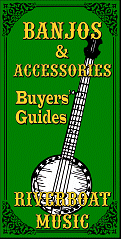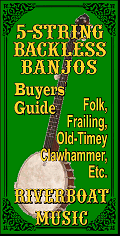Acoustic Instrument
Primers
What Kind of Guitar
Should I Start On?
What Kind of Banjo
Do I Want?
Evaluating and
Buying Used
Guitars
Setting Up
Fretted Instruments Whatever Happened
to the Banjo?
Beginning Five-
String Folk Banjo
6-String Banjos
Banjo Pickups
Axes in my Life
What is a
Bluegrass Banjo?
Dean "Backwoods
Six" Shootout
What is a Zither Banjo?
Music Theory
Primers
Introduction
to Scales
Introduction
to Chords
Circle of Fifths
Other Articles
About Music
How to Give
Guitar Lessons
Musician or
Wannabe? Did God Really
Give Rock &
Roll to You?
Are You a
"Brand Bigot"?
Who Owns Folk Songs?
Historical Links
About the
National Road
The Story Behind
the Story - Real
People, Places,
and Events
About the Play
Play Home
What's New
Overview
About the
Music
About the
History
About the
Logistics
About the
Cast
Synopsis
About the
Set
About the
Author
Contact Us
Home

Lesson 1c: Right-Hand Positioning and Exercises
| Edited by Paul Race for Creek Don't Rise? |
|
Editor's Note: Between 1999 and 2004, Mitchel "Mickey" Cochran posted an extensive collection of free musical instrument lessons on his FolkOfTheWood.com web page. Sadly, we lost Mickey in 2011. After e-mailing surviving family members for permission to repost some of Mickey's most popular materials, we have begun restoring them to host on these pages. (Please see the Introduction page for more information on that effort.) This page is Mickey's explanation of how to hold your hand and how to user your fingers when playing the 5-string banjo. - Paul Race |
Lesson 1c: Right-Hand Positioning and ExercisesRight hand positioning is very critical to properly learning how to play. To gain a good foundation by establishing good habits from the start should be your objective. Place the right hand comfortably over the strings while placing your little finger on the banjo head. Your thumb and fingers will now be free to play without losing their place. The right hand will now pivot from the little finger which remains stationary on the head. Now, remember, your little finger is only supporting the position of the right hand; you will still need to keep it free enough to slide up and down from the bridge to the end of the fingerboard. For now, simply place it a couple of inches from the bridge towards the fingerboard. Notes on using a Thumbpick and Fingerpicks: 4.
All new fingerpicks need to be shaped before using...bend the tip of
the fingerpick back and tighten the collar, that wraps around the
finger, so that it fits tightly and comrortably. Be careful not to
overtighten...after playing and experimenting, you'll find you very own
happy medium on shaping the metal fingerpicks. Notes on Right Hand Positioning: Further Notes on Right Hand Positioning: How to read the number system (tablature) Notice the string names to the left of each line. Picture these lines as the strings on your banjo. The very top line is the bottom string of your banjo. The bottom line is the top string of your banjo. The numbers on each line represent where the string is to be played. For instance, a "0" on the top line means to play the D string open. A "2" on the top line means to play the D string at the 2nd fret. In the following exercises, all strings are played open...notice that the only number on the tablature is the numeral "0". These studies are all played in the open position, without fretting, so that the focus will be on the picking hand...to ensure that you're not distracted with having to work both hands at the same time. There are 4 beats to each measure...for each measure count out four beats as if you're keeping the rhythm by clapping your hands or tapping your foot. Note: Keep in mind that you're trying to keep these notes played evenly without faltering. There are no pauses between the notes. Start off slowly and keep the timing even. Thumb = T
Practice these rolls repetitively. Our goal is to first gain a strong right hand before we attempt to add our left hand chords. We will learn a couple of more right hand rolls in the lesson 3. Copyright ?1999-2004 Mickey Cochran |
Conclusion
Mickey's instructions are as valid today as when he wrote and recorded them years ago. Here's hoping that you find them just as helpful as his original followers did back when he was interacting on a daily basis with his them.
Please contact us if you're hitting any brick walls and we'll try to help you get therough them.
Best of luck, all, enjoy your music, and support the arts.
Paul Race
And when you're ready to move on, click here to go to the next part of this online lesson.

|

|


All text and any illustrations and/or videos within the white box above are copyright 1999-2004 by Mitchell Cochran. All other materials, illustrations, and content on this web page, including the text reformatting and illustration restoration within the white box are copyrighted ? 2016 by Paul D. Race. All rights reserved.
Creek Dont' Rise(tm) is a participant in the Amazon Services LLC Associates Program, an affiliate advertising
program designed to provide a means for sites to earn advertising fees by advertising and linking to Amazon.com.
For questions, comments, suggestions, trouble reports, etc. about this page or this site, please contact us.
| Visit related pages and affiliated sites: | |||||
| - Music - | |||||

|
 |
 |

|

|

|

|

|

|

|

|

|

|

|

|

|

|

|
| - Trains and Hobbies - | |||||
 |

|

|  |
 |

|
| - Christmas Memories and Collectibles - | |||||
 |

|
 |

|
 |

|
| - Family Activities and Crafts - | |||||
 |

|

|

|

|

|

